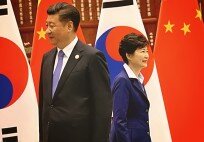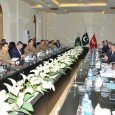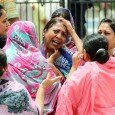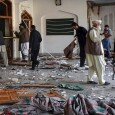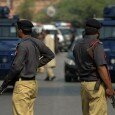By Ehsan Mehmood Khan –
Picking up the pace
The war on terror being fought by Pakistan has entered the second decade now. During the last decade, the Pakistani nation suffered hugely across all human spheres e.g. physical, psychological, social and economic, in addition to the image loss in front of the world. Since 2004, Pakistan’s security forces have conducted some 475 major and 133 minor operations to clear all agencies of the Federally Administered Tribal Areas (FATA), including Bajaur, Mohmand, Khyber, Kurram, Orakzai and South Waziristan besides the Provincially Administered Tribal Areas (PATA), Malakand Division including Swat. North Waziristan Agency (NWA) awaited a major offensive operation as it had become a hub of terrorists from various factions and organizations including the foreigners.
NWA was a no-go area for the state administration in general. Media, domestic and international, could not think of getting access to the area. For the people of settled areas of Pakistan and the world at large, NWA was no less a mystery than the Caucasus typified in fairy tales. To restore peace and bring back normalcy in NWA and other conflict-hit areas, the government gave the peace process a last chance but the terrorists have never been sincere towards a dialogued peace. During the peace talks, they launched 20 major terror attacks from January 29 to June 8, 2014, in which 195 Pakistanis embraced shahadat. This led to the political decision of launching Operation Zarb-e-Azb, which may be termed the ultimate rejoinder to terrorism. It is a national effort and is the interplay of all instruments of statecraft. The Army is spearheading the kinetic prong besides assisting the civil administration in settlement of Internally Displaced Persons (IDPs).
Commencement
The operation in NWA commenced on June 15, 2014. Air strikes were launched on the hideouts of terrorists the same day. Nearly one million people of NWA were rendered IDPs. Their movement towards Bannu and Bakka Khel, where a camp had been set up by the government, was facilitated from June 18 to June 23, 2014. The ground operation was delayed for another seven days so as to let the innocent tribal people come out of the agency safely, and was finally launched on June 30, 2014. The forces started operating with full zeal and were supported by the entire nation.
Progress
Operation Zarb-e-Azb is progressing as planned. Miran Shah, the capital of NWA, has already been cleared. It is no more a no-go area. Media persons have visited the town and walked through its bazaars freely. The ground operation in other parts of NWA including the town of Mir Ali goes on. There are pockets of resistance in and around Mir Ali and other towns of NWA, which are being cleared. Till now, over 500 terrorists have been killed and some 30 terrorists have surrendered to the security forces. Nearly 90 terrorist sanctuaries and hideouts have been destroyed. Besides, around 12 IED-making factories and approximately 23 tons explosives have been seized in addition to scores of weapons, bullets, projectiles, grenades and rockets. Some 30 security forces personnel have embraced shahadat since the commencement of operation, while 88 have been injured.

Integrated Security Mechanism (ISM)
There have been a few acts of terror since the operation began. On July 11, 2014, the militants set ablaze three vehicles of the Frontier Works Organisation in the Shagaye area of the Khyber tribal region’s Jamrud tehsil. Jaish-i-Khurasan organisation distributed threatening pamphlets that Kasadar force and other government officials should quit their jobs or else would be targeted. Likewise, in an attack on a security check post from across the Pakistan-Afghanistan border, the terrorists killed three security forces personnel including a captain on July 12, 2014. Yet again, on July 18, 2014, five Frontier Corps soldiers embraced shahadat when heavily armed terrorists attacked a security checkpost in Jamrud tehsil.
There have been a few more incidents of the kind. However, blowback has been negligible due to the strong measures taken to counter them.
To ward off the blowback outside NWA, especially in the major cities of Pakistan, an integrated security mechanism (ISM) has been put into execution. This mechanism is led by the civilian LEAs under the federal and provincial governments, but is intimately supported by Pakistan Army. Intelligence agencies are working hand in glove with the LEAs. Over a hundred intelligence based operations (IBOs) have been conducted as part of the ISM in which, according to media reports, more that 500 suspected terrorists mostly belonging to the proscribed outfits have been apprehended from various parts of the country.
The key members of TTP such as Adnan Rashid are part of the list. He is reported to have been arrested from the Shakai valley of South Waziristan. These detainees would be treated under the newly legislated Protection of Pakistan Act (PPA) 2014. Recent operations in Darel area of Diamer Valley, Raiwind near Lahore, South Waziristan and some other areas of the country are part of the same strategic endeavour. The state security agencies are performing their role in conjunction with each other for synergetic effect. On the whole, the operation continues on a high pace.
Economy of terror
NWA has been an archetypal case of terror economy in the region. Subsisting under the weight of terrorism, people of Waziristan started to live by the way of violence. The economic system of the agency also became linked with the terror mechanism. Bomb-manufacturing turned into an industry and bomb-selling into a trade. Every terror outfit had its own allied IED factories, godowns and shops. The trade of arms, ammunition and explosive has been another feature of the NWA’s economy. Extortion from within NWA, from major cities including Karachi and the vehicles passing through NWA, and kidnapping for ransom have been the key pillars of the terror economy. Countless heirs of the abductees were compelled to pay in millions to get back the kidnapped people, and out of fear they never reported the incident to police or media.

According to an intelligence report, the TTP amasses around rupees 2 billion ($20 million) in extortion money from Karachi every day. According to another report dating back to February 2014, TTP earns about 115 million dollars monthly through extortion from Karachi. They are also involved in generating money in Karachi from the Pashtun traders and transporters through extortion, donations, kidnapping, and Zakat and Fitrana collection. All this had a linkage with the main terror base located in NWA. According to police sources, TTP members robbed Karachi banks of rupees 1.7 billion ($17 million) from 2009 to 2012. Police arrested 42 TTP activists in 2010 and 2011 in connection with various robberies.
The hotels in Miran Shah have been hosting the terrorists from other areas including the foreigners. Some foreign terrorists have also been living as paying guests with different local families in the agency. Funding from abroad and from local financers has been another key facet of the terror economy. Pakistan is a poppy-free country. However, due to its proximity with Afghanistan and for being located on a drug trade route, the drug business had a definitive share in NWA’s terror economy, which was composed of floating money containing billions of rupees, riyals, dirhams and dollars. Reportedly, the treasury of the TTP called bait-ul-maal holds billions.
Operation Zarb-e-Azb has destroyed the entire economic structure based on the terror campaign including the movement and activities of terrorists. To build it again, the terrorists need to win back NWA, something far from probable right now. They would never openly challenge the professional LEAs including Pakistan Army.
Foreign terrorists
The question as to whether the operation is being conducted against all terrorists has been responded through action rather than words alone. The terrorists of all shades and grades, and all nationalities have been targeted. It needs particular mention that the few members of the East Turkestan Islamic Movement (ETIM) dwelling in NWA with TTP have also been targeted effectively. Many of them have been killed. Their headquarters located in Miran Shah has also been destroyed.
According to the military sources, the presence of al-Qaeda has also been felt in Miran Shah. Some al-Qaeda-linked literature has been seized during the operation. There are signs of other foreign terrorists such as Uzbeks, Tajiks, Chechens, Turkmen and Uighurs. Their terror abodes have been destroyed.
IDPs
The issue of internally displaced persons (IDPs) is the most significant of all, and may turn most sensitive in the post-operation rehabilitation phase. The mass of IDPs of NWA, some 79,500 families comprising a little less than one million (912,029) individuals, marks to be the second largest internal displacement during the recent years after Swat. Only about 65 families (401 individuals) are living in the camp established by the government. Remaining IDPs have either shifted with their relatives or in their second homes, and some of them even in rented houses. Taking care of the IDPs is a national responsibility warranting response from all individuals and institutions of the country.
Some of the details pertaining assistance provided to the IDPs are as follows:
- Rs 346.1 million cash distributed to 27903 IDP families at the rate of Rs.12,000 per family
- 4477.5 tons worth of ration distributed over 40,000 IDP families
- Field hospital established at Khalifa Gul Nawaz Hospital (Bannu) by the army
- Polio vaccination administered to 221,000 IDPs
- 12,151 cattle treated and 30,337 cattle / 39277 poultry vaccinated as per veterinary services
The safe return home of the IDPs is contingent upon the security situation and the comeback of normalcy to NWA. However, their safekeeping and human security is a function of national passion and the amount of support extended to them by each of us. It is a great act of piety and generosity to help the IDPs in whatever the way is possible. Pakistan is a nation known for its generosity and kind-heartedness. Certainly, when the Pakistani government says no to foreign aid with regard to support of the IDPs, it is indeed depending on its own resources and on the support from the nation.
Various government departments and individuals have made some noteworthy contributions. Details are as follows:

Conclusion
Operation Zarb-e-Azb is not just a military operation. It is a national effort involving all segments of the Pakistani society. Some quarters often ask as to whether the polity and military are on the same page as regards the operation. This query is no more relevant. As a matter of fact, the entire nation is on the same page from a peon to prime minister, something that adds confidence with regards to the operation’s success. It is a matter of prime importance for all segments of the nation to support the LEAs in their frontline role in this decisive phase of the war on terror, besides playing their own part in their respective professions and capacity. This would greatly contribute towards driving the last nail in the coffin of terrorism with nationalistic ardour and military precision, and thus dictate an outcome in the war for our homeland.
The writer is a PhD (Peace and Conflict Studies) scholar and author of Human Security in Pakistan (published 2013) and co-author of Kashmir: Looking Beyond the Peril (published 2014) Email: [email protected]




















































